What Factors Drive Fish To Jump Out Of The Water And Into The Land?
Near the town of Chesseide in southeastern Scotland, is a peaceful idyllic village. But more than 300 million years ago, it used to be a tropical swamp. Rocks in the village revealed to us the appearance of hundreds of millions of years ago here: hot and humid, a variety of ferns, horsetail intertwined growth, there are 30 meters high, shaped like a giant asparagus sharp stone pine.
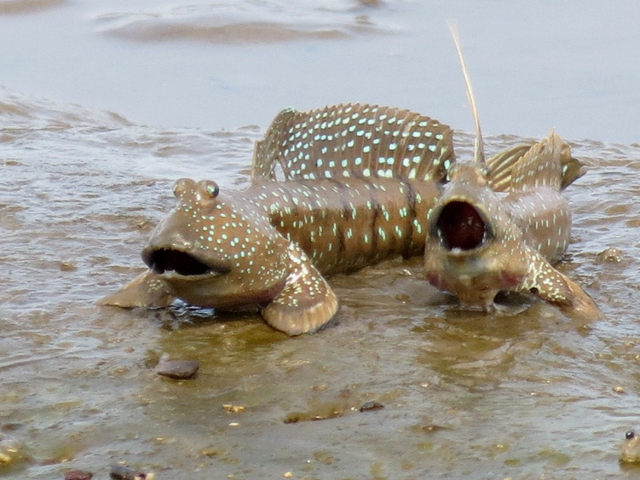
Mudskippers could shed light on how fish made the leap to land
source
About 350 million years ago, you were on the edge of a muddy shoal where you might see a pair of eyes looming on the water. This is a kind of salamander creatures, with wide mouth big mouth fangs, there is a long tail. It twisted his limbs, dragging his legs, slowly toward the shore.
This amphibian vertebrate is nicknamed Tiny by its discoverer. You may have never heard of it, but it is one of the most important fossils. In the days of Tiny's existence, one of the most significant turning points in life's history - creatures like fish dragged their bodies and transformed from water to land habitats, to the emergence of amphibians, reptiles and mammals Foundation. But unfortunately, the fossil record of this period is very scarce.
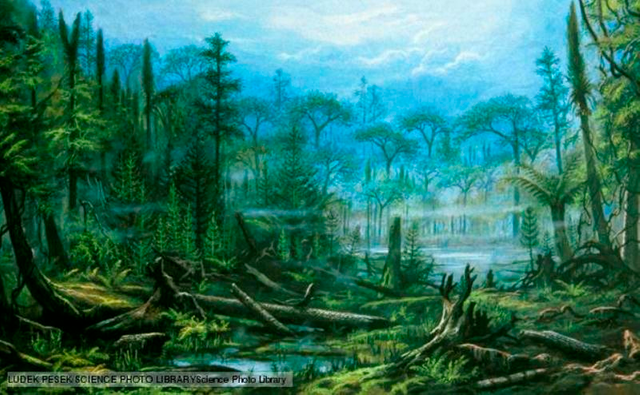
Carboniferous swamp ecological restoration map
More than just Tiny, other recent discoveries are challenging our view of aquatic lands. In our imagination, the scene of animal landing is such that some of the stronger creatures evolved limbs in their evolution, replacing their fins, plunged into the ground after inhaling one breath. Today, however, we find that landing may be based on a more contingent change: in the process, the size and location of these animals' eyes may play an equally important role in the appearance of the limbs.
Disappeared 15 million years ago
We have now discovered some precious fossils that tell the story of evolution from fish to quadrupeds. For example, paleontologists discovered a group of fish fossils dating back 375 million years ago, the late Devonian. These fossils show the transitional stages in the evolution of the fins to the extremities and toes, which eventually lead the fish to land. The appearance of primitive meatfin fish, the ancestor of today's lungfish, marks the beginning of the transition. After studying fossils of the Panderichthys in Latvia and Tiktaalik in Ellesmere in Canada, the transformation from the fins to the protuberances of the extremities was revealed.
After a long evolution of about 10 million years later, vertebrates gradually became more adaptive to onshore activities. Acanthostega emerged in the process. The salamander is about 60 cm long and has well-defined limbs and 8 toes. In addition, there is a larger, with seven toes Ichthyostega. According to recent research, this type of body structure is actually more suitable for living in the water, but the fish I can drag along the muddy shore of their own body forward. Evolved so far, early quadrupeds already had limbs, toes, and the ability to breathe air from ancestors like lungfish. For them, landing life seems quite comfortable.
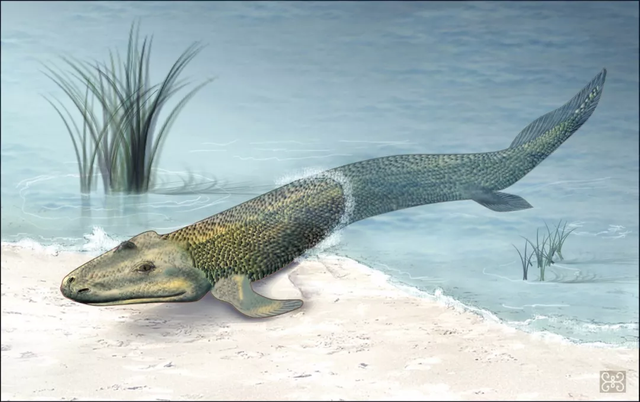
Tiktaalik Recovery, Source: National Science Foundation
But at this crucial transitional period, fossils have disappeared. During the first 15 million years of the Carboniferous - about 3.6 to 345 million years ago, the offspring of the first four-legged animals seemed to be very sparse. Paleontologists have predicted that the number of quadrupeds will surge at this stage, but the number of fossils found is only a handful.
This huge gap in fossil record was first noticed by the American paleontologist Alfred Romer and was therefore called Romer's Gap. For a long time, we can not explain what happened during this period of time. Why is the number of fossils so sparse?
Paleontologist Peter Ward of Washington University in Seattle and other researchers believe the answer may be oxygen. In the tens of millions of years before the infamous vacancies, some arthropods, such as the early arachnids, flourished on land. But in a vacancy, they are struggling. This can not help but make one guess whether the interruption of the fossil record was due to a serious decline in the oxygen content of the atmosphere. With less oxygen in the air, breathing becomes more difficult, posing obstacles for the animals trying to land ashore, but only as amphibians for short periods of time out of the water.
But then the fossil record gave us a surprise. In 2002, Jennifer Clack of the University of Cambridge and her colleagues examined the bones of the Pertepes finneyae, a species of the genus Waterta. It was previously thought that this was a fish that had been in a vacancy of 348 million years ago, but Clack thought it was a quadruped with five toes and significantly fewer toes than its ancestors. Although not completely terrestrial, the animal's anatomical features indicate that it is more adaptive to terrestrial life than any previous vertebrate. More importantly, this implies that the period of vacancies may not be so barren.
An important discovery during the "Barren" period
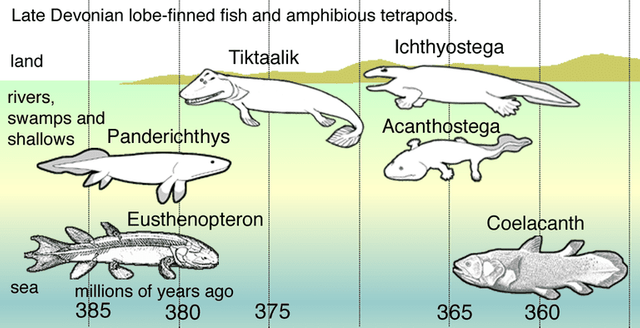
source
Inspired by Clack's discovery, paleontologists have taken a more detailed look at the long-overlooked rocks of the infamous Memphis, with surprising results. In 2015, Jason Anderson of the University of Calgary and his team discovered a group of fossils at the Blue Beach in Nova Scotia, Canada. The study concluded that there are a variety of quadrupeds during the soft vacancies.
The following year, Clack and his colleagues returned to the river not far from Cienseide and discovered a large number of new fossils - not one, but five new four-legged species.
The reason why these fossils have not been discovered for a long time is that there are no commercially available resources such as coal, limestone or iron ore in rock during the soft vacancies. "Their 'barrenness' makes them long-term considered as unexplored," Clark said frankly.
For paleontologists, however, these fossils contain enough precious treasure to subvert the process of biological evolution. One of them is Aytonerpeton microps, which is Tiny mentioned at the beginning of the article. Tiny's name comes from its small 5cm long head, which is very small compared to other amphibians at the time. The advent of Tiny shows that quadrupeds have now evolved a series of body shapes, which is why they are so special. Tiny and its classmates, though unlikely to become a household name, have been fascinated by paleontologists for their role in filling the gaps.
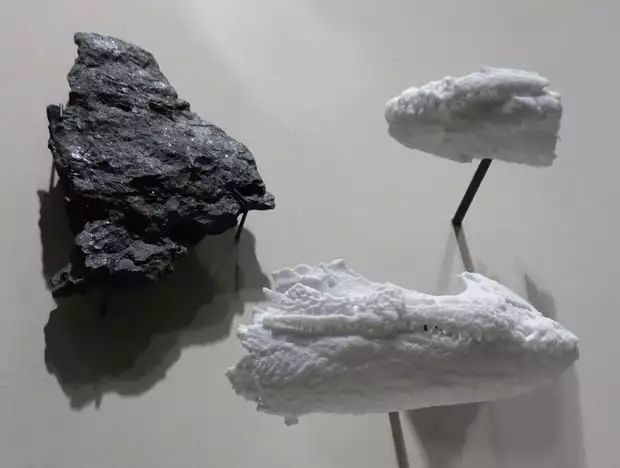
Tiny fossil model, located in the Scottish National Museum
In addition, the same period of charcoal fossils reveal the existence of fire, which overthrows the hypothesis of a serious decline in oxygen levels. There are also some clues that invertebrates did not suffer from what the researchers had previously imagined. In other words, it is not the period of soft vacancies that the harsh terrestrial environment prevented the landing of creatures, but paleontologists had not yet found the fossils of that period.
According to the latest findings, we have a clear understanding of this long-standing evolutionary "blind spot." Instead of suffering in a depressing environment, these early vertebrates are rapidly evolving and diversified. Clack said: "From this moment on, quadrupeds really started using the land, and they still live mainly in the water, but changing conditions seem to have boosted their ability to feed and live on land."
Broader land view
So why? Is vertebrate moving back and forth between water and land, adapting to the new environment through changes in various body structures, being threatened by predators in water, or from the temptation of new food on land?
Malcolm MacIver, a neuroscientist at Northwestern University in the United States, is trying to look at this type of problem from another entirely new perspective. He had previously studied how electric wire eels use current to detect prey in the water, thus reminiscent of: How did the first terrestrial vertebrate perceive the environment? Therefore, MacIver turns her attention to their eyes.
MacIver and colleagues measured orbital fossils of quadruped animals from 390 million years to 290 million years ago found that during this time the quadrupeds had twice as many orbital eyes and gradually moved to the head during growth . For example, TITLIK fish, which is still an aquatic animal, but the size and location of its eyes indicate that it has been able to see what is happening on the surface of the water. What surprised MacIver most, however, was that these changes came before the early quadrupeds grew their landed limbs.
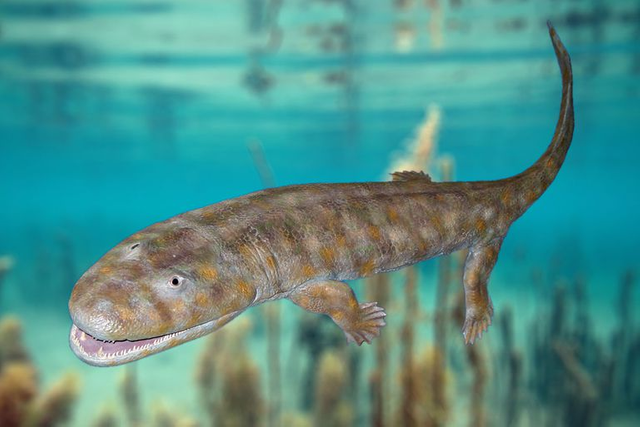
Model of Acanthostega, an extinct tetrapod that was among the first vertebrates to have evolved limbs. Acanthostega represents an intermediate form between lobe-finned fishes and early amphibians. Acanthostega lived about 365 million years ago.
From a biological point of view, the growth of the eye needs a lot of resources to maintain, then the eyes become larger, grow to the top What are the benefits? To find the answer, MacIver and his colleagues used experimental data from existing organisms to simulate what these prehistoric animals' eyes could see above and below the water. They found that getting bigger eyes may not be helpful under the water, but once these "detectors" crossed the water, it was another story. In the air, the eye size is proportional to the visual range.
So what exactly do these "detectors" look to? MacIver said that because many arthropods are undefended to such predators, greater eyes and better eyesight provide a tether information chain for predation of terrestrial invertebrates, which may attract early four-legged Animals crawl out of the water for delicious food.
Of course, just to see farther places is not enough to promote the aquatic transition to land. But MacIver believes that once the ancestors of quadrupeds catch a glimpse of those delicious and affordable foods, limbs and structures that support the skeleton of the body on land, they gain the favor of natural selection.
Anderson praised the hypothesis and the novelty of the proposed hypothesis, even though he held a reservation about the size of the quadrupedal eye as a function of eye size: "This requires more in-depth research later on."
The nature of paleontology so. Each new discovery and the new hypothesis raise more questions. It not only includes the vacancy but also a series of problems in the first hard landing of aquatic animals, which all need us to explore further.
What Clark most wants to know is more about the details of the first landing strategy for biological reproduction. Although they have landed, their breeding habits are still closely linked to the water. There are a few questions here: are their habits similar to those of modern amphibians? When did the first egg that survived on land appear? She thinks it is possible to answer these questions if she needs a specific preserved fossil. Similarly, we still do not know why the five-toed quadrupeds will be the standard.
Anderson said: We now know that soft vacancies are just a few of the problems caused by the lack of samples, and the answer is hidden in the fossil record. He looked forward to discovering more details in future research, from which we can see the great leap forward in exploration.
Sources for Text and Images:
- https://www.newscientist.com/article/mg23531350-100-the-eyes-have-it-how-spotting-naive-prey-made-fish-walk-on-land/
- https://www.thoughtco.com/storming-the-beaches-129438
- http://www.wbur.org/hereandnow/2017/08/15/ends-of-the-world-peter-brannen
- https://www.quora.com/Why-do-some-fish-jump-out-of-the-water
- https://www.theguardian.com/science/2014/jan/13/tiktaalik-fossil-fish-four-legged-land-animal
Support @steemstem and the #steemstem
project - curating and supporting
quality STEM related content on Steemit

This is a test comment, notify @kryzsec on discord if there are any errors please.
Being A SteemStem Member
Evolution of the sea species is really an interesting subject.
thanks for reading and knowing your interest. hope you like my other articles also.
Best wishes.
A beautiful fish reminds me of one of the cartoons I was watching at a young age
This post has received a 1.18% upvote from thanks to: @marverick984.
thanks to: @marverick984.
For more information, click here!!!!
Send minimum 0.050 SBD|STEEM to bid for votes.
Do you know, you can also earn daily passive income simply by delegating your Steem Power to @minnowhelper by clicking following links: 10SP, 100SP, 500SP, 1000SP or Another amount
Congratulations! This post has been awarded a 100% upvote by @lottobot! This post was the winner of lottery #1374, which had a total of 2 entries. @lottobot always has a lottery going on! If you would like to nominate a post for the current lottery, just send 0.1 SBD or STEEM to @lottobot, and include the url of the post you would like to nominate as a memo. Learn more by reading the introductory post! Good luck!
@resteemator is a new bot casting votes for its followers. Follow @resteemator and vote this comment to increase your chance to be voted in the future!
Greetings! I am a minnow exclusive bot that gives a 5X upvote! I recommend this amazing guide on how to be a steemit rockstar! I was made by @EarthNation to make Steemit easier and more rewarding for minnows.
wonderful post : I really love the ticktaalik buddy ! how amazing is the adaptability skill for surviving... I guess the human race is also like that : we are changing, age after age. Thank you !
super interesting